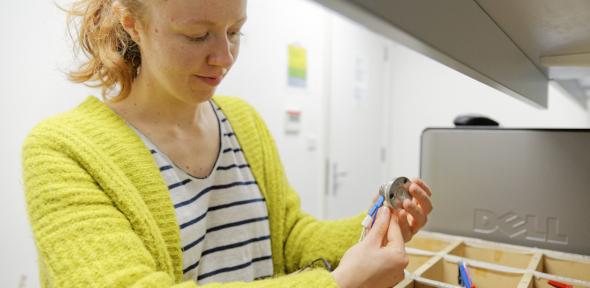
PhD student Alice Merryweather is a member of the Faraday battery project team
A new, low-cost technique for measuring energy storage inside operating batteries should speed up the development of next-generation battery materials.
The new technology is based on an optical microscopy technique developed by researchers in the Grey group here and the Rao group in the Cavendish Laboratory as part of a Faraday Institution battery characterisation project.
Faraday Institution Entrepreneurial Fellowship
The team plans to commercialise the technology through spinout company Illumion, which is being set up in the coming months with the support of a Faraday Institution Entrepreneurial Fellowship.
Currently, studying the behaviour of the lithium ions, and how they enter a battery’s active material, is time-consuming and requires the use of expensive synchrotron x-ray or electron microscopy techniques. “It’s an incredibly complex process to look at,” says Dr Christoph Schnedermann from the Cavendish Laboratory, who is leading the multi-disciplinary team receiving the Entrepreneurial Fellowship. “So if you want to make a new battery, it takes a long time and the characterisation process for new materials is arduous. We wanted to better understand what happens inside these battery materials.”
The optical microscopy technique, called interferometric scattering microscopy, was developed over three years by Dr Schnedermann and Dr Akshay Rao from the Cavendish with PhD student Alice Merryweather, postdoctoral researcher Quentin Jacquet and Professor Dame Clare Grey from this Department. Alice Merryweather outlined the new technique at the Faraday Institution Conference in November 2021.
Looking inside an operating battery
“This allows us to look inside a battery, identify individual active particles and observe, under a microscope, the changes that happen to these particles while the battery is running,” Dr Schnedermann explains. “So we can take a battery material, put it into our microscope system, and tell you how the ions go in and out, when and how it might crack or break or degrade in some other unexpected way. And from that we can quickly provide detailed information on why a battery could potentially fail.”
The technique uses a laboratory-based microscope, giving researchers quick and easy access to the type of information that they would have previously needed to wait for beam time at central facilities like Diamond.
The Entrepreneurial Fellowship will help the team build their company with the aim of getting this breakthrough to those in the industry as well as academia. They are already working with partners to test the system, and Dr Schnedermann says that initially it could prove particularly useful for small businesses developing new batteries.
Saving time and money
“If you’re a start-up with a fantastic new battery material, it’s unlikely you’ll be able to do all the characterisation work in-house,” he says. “Our technique will not only tell you more about your materials, but it also is going to be four or five times cheaper than anything you can buy in currently, which means it becomes much more affordable for young companies to optimise their materials. Our initial target is to provide this as an R&D tool for these businesses, and then to try and get it into the research departments of the big players in the industry.”
By identifying and correcting defects at an earlier stage, Dr Schnedermann believes Illumion’s technique can have a substantial impact on streamlining battery development. “The overall development cycle of a battery is currently about ten years,” he says. “If we can shave even five per cent off that in terms of the time and money it takes, that’s a massive opportunity.”
By the numbers
Six months – average wait time to gain access to a synchrotron beam machine
24/7 – availability of Illumion’s in-house method
£100,000 – cost of use a single synchrotron beam machine
£50,000 – minimum cost saving per microscope using Illumion
12,000 – readers accessing the Nature paper detailing the company’s technology
Research
Merryweather, A.J., Schnedermann, C., Jacquet, Q. et al. Operando optical tracking of single-particle ion dynamics in batteries. Nature, 594, 522–528 (2021).
